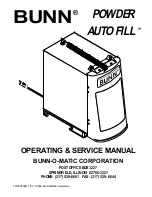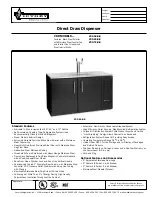
2
Culligan® High Efficiency 1.5 Twin Water Softener
2
Cat. No. 01024821
Basic Principles
What Is Hard Water?
Water is said to be hard when it carries too high a concentration of calcium and magnesium. Acceptable water hardness
levels will vary depending on the application.
Why Should Hardness Be Removed?
Hard water causes scaling and etching which greatly impairs the life and efficiency of boilers, air-conditioning systems,
cooling towers, water heaters, refrigeration plants and other equipment using water.
How Does It Work?
The components of dissolved minerals are called ions. They carry either a positive or negative charge. Hardness ions of
minerals dissolved in water carry a positive charge. These positively charged ions (cations) are attracted to a synthetic
softening material called ion exchange resin.
The heart of the softening system, therefore, is a deep bed of resin which draws calcium and magnesium ions, as well as
ferrous iron, from the water as it passes through the resin bed.
Can The Resin Draw Out Hardness Ions Indefinitely?
No. During normal operation, the resin becomes saturated with positive ions and functions less efficiently. When hardness
leakage occurs, the resin should be regenerated to restore its efficiency.
How Do You Regenerate Resin?
You regenerate a resin bed by removing the mineral ions through a process called ion exchange. This regeneration pro-
cess occurs in four steps and takes approximately 80 to 90 minutes.
Backwash
During the backwash step, raw water flows rapidly upward (in reverse direction to the service flow) through the resin bed
to expand the bed and flush out accumulated dirt, sediment and other sources of turbidity.
Brine Draw
The brine solution consisting of water and salt is drawn from a brine storage tank and allowed to flow slowly down through
the resin bed. The brine solution removes the calcium and magnesium ions from the resin. This cycle can also be split into
three “sub-cycles” which allow for the cost saving feature of brine reclaim.
Slow Rinse
Brine draw is then followed by a raw water slow rinse. This rinse step will slowly remove most of the remaining brine,
exchanged calcium and magnesium ions from the resin. This cycle can also be split into three “sub-titles” which allow for
the cost saving feature of brine reclaim.
Fast Rinse
Slow rinse is followed by a raw water flush, a very rapid down flow of raw water which removes the last traces of brine,
and settles the resin bed.
How Often Must You Regenerate?
Frequency must be determined for each installation based on the amount of water usage, its degree of hardness and the
amount of resin through which it flows. In some cases it is necessary to utilize a resin cleaner when the raw water con-
tains iron. Contact your local Culligan dealer for more information.
How Do You Control The Regeneration Process?
The regeneration process for your commercial water softener is controlled automatically either on a predetermined time,
volume, or external signal basis through the use of the Culligan Smart Controller with optional flow sensor. See the Instal-
lation chapter for further information. The regeneration process can also be initiated manually by the operator as required.







































